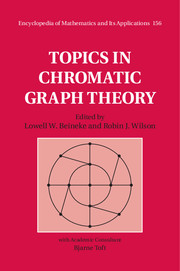Book contents
- Frontmatter
- Contents
- Foreword
- Preface
- Preliminaries
- 1 Colouring graphs on surfaces
- 2 Brooks's theorem
- 3 Chromatic polynomials
- 4 Hadwiger's conjecture
- 5 Edge-colourings
- 6 List-colourings
- 7 Perfect graphs
- 8 Geometric graphs
- 9 Integer flows and orientations
- 10 Colouring random graphs
- 11 Hypergraph colouring
- 12 Chromatic scheduling
- 13 Graph colouring algorithms
- 14 Colouring games
- 15 Unsolved graph colouring problems
- Notes on contributors
- Index
- References
11 - Hypergraph colouring
Published online by Cambridge University Press: 05 May 2015
- Frontmatter
- Contents
- Foreword
- Preface
- Preliminaries
- 1 Colouring graphs on surfaces
- 2 Brooks's theorem
- 3 Chromatic polynomials
- 4 Hadwiger's conjecture
- 5 Edge-colourings
- 6 List-colourings
- 7 Perfect graphs
- 8 Geometric graphs
- 9 Integer flows and orientations
- 10 Colouring random graphs
- 11 Hypergraph colouring
- 12 Chromatic scheduling
- 13 Graph colouring algorithms
- 14 Colouring games
- 15 Unsolved graph colouring problems
- Notes on contributors
- Index
- References
Summary
We discuss the colouring theory of finite set systems. This is not merely an extension of results from collections of 2-element sets (graphs) to larger sets. The wider structure (hypergraphs) offers many interesting new kinds of problems, which either have no analogues in graph theory or become trivial when we restrict them to graphs.
Introduction
In this introductory section we give the most important definitions required to study hypergraph colouring, and briefly survey the half-century history of this topic. For more details on the material of Sections 1 and 2 we refer to Berge [8], Zykov [76] and Duchet [27].
Let V = {v1, v2, …, vn} be a finite set of elements called vertices, and let ℇ = {E1, E2, …, Em} be a family of subsets of V called edges or hyperedges. The pair ℌ = (V, ℇ) is called a hypergraph with vertex-set V = V(ℌ) and edge-set ℇ = ℇ(ℌ). The hypergraph ℌ = (V, ℇ) is sometimes called a set system. If each edge of a hypergraph contains precisely two vertices, then it is a graph. As in graph theory, the number |V| = n is called the order of the hypergraph. Edges with fewer than two elements are usually allowed, but will be disregarded here. Thus, throughout this chapter we assume that each edge E ∈ ℇ contains at least two vertices, unless stated explicitly otherwise. Edges that coincide are called multiple edges.
In a hypergraph, two vertices are said to be adjacent if there is an edge containing both of these vertices. The adjacent vertices are sometimes called neighbours of each other, and the set of neighbours of a given vertex v is called the (open) neighbourhood N(v) of v. If v ∈ E, then the vertex v and the edge E are incident with each other. For an edge E, the number |E| is called the size or cardinality of E.
- Type
- Chapter
- Information
- Topics in Chromatic Graph Theory , pp. 230 - 254Publisher: Cambridge University PressPrint publication year: 2015
References
- 1
- Cited by



